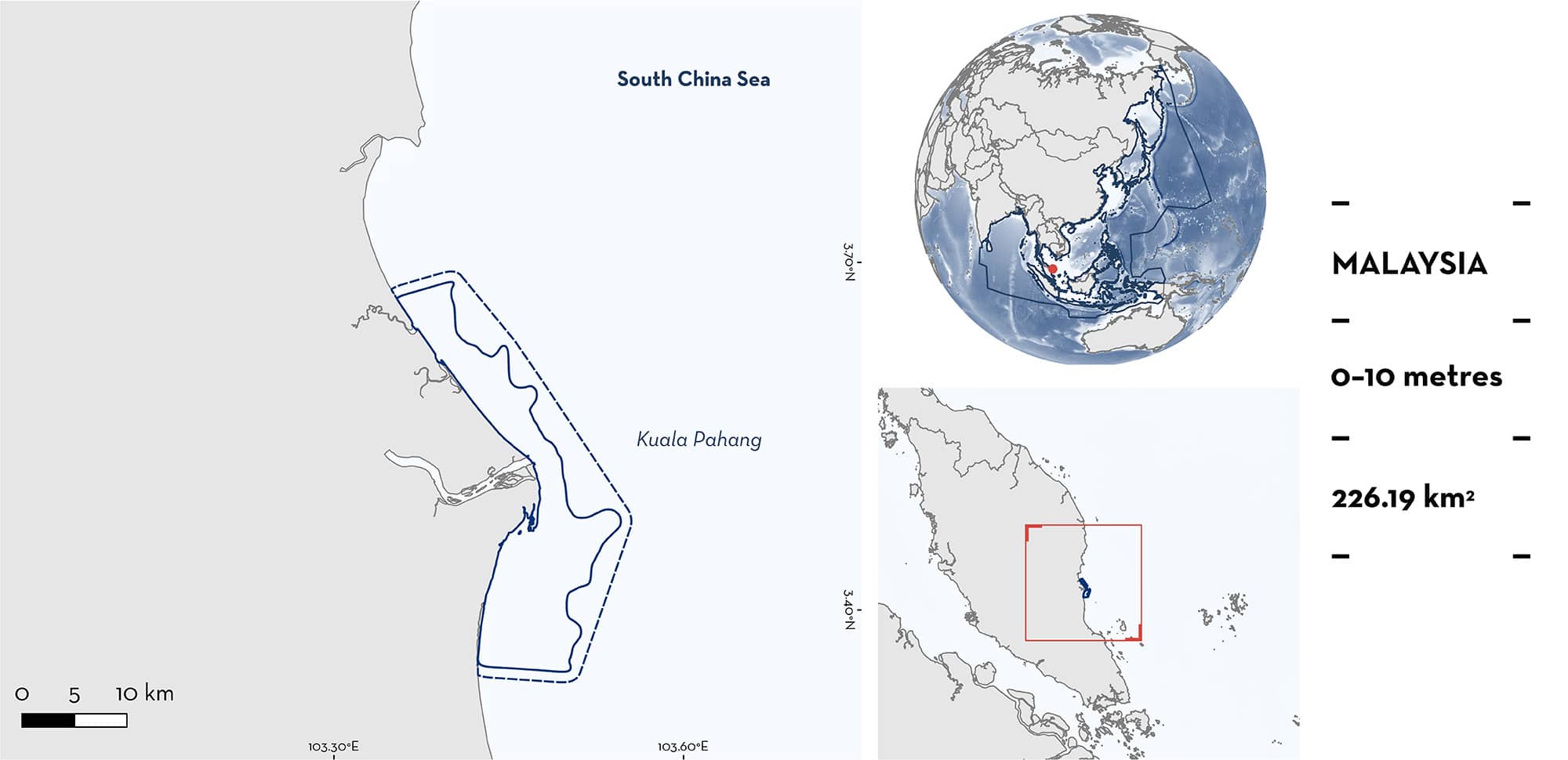ISRA FACTSHEETS
ISRA FACTSHEETS
ASIA REGION
Kuala Pahang
Summary
Kuala Pahang is located on the east coast of Peninsular Malaysia in the Gulf of Thailand. It is comprised of shallow coastal benthic habitats with sandy substrates, centred around the entrance of the Pahang River (known as Kuala Pahang). The area is influenced by the northeast monsoon season (November–March), which brings heavy rain to the area. The area partly overlaps with the Redang Island Archipelago and Adjacent Area Ecologically or Biologically Significant Marine Area. Within this area there are: threatened species (e.g., Indonesian Bambooshark Chiloscyllium hasselti), and reproductive areas (e.g., Dwarf Whipray Brevitrygon heterura).
Download factsheet
Kuala Pahang
DESCRIPTION OF HABITAT
Kuala Pahang is located on the east coast of Peninsular Malaysia in the Gulf of Thailand. It is a shallow area that covers the coastal area to the north and south of the Pahang River (known as Kuala Pahang). It is characterised by sandy substrates, with mangrove habitats occurring along the adjacent coastlines. The Pahang River is the longest river in Peninsular Malaysia and floods annually during the wet season (November–March), which is triggered by the northeast monsoon (Muhamad et al. 2013). Flood events result in sedimentation transport in the estuary and out into the Kuala Pahang area. Oceanographic events in the broader Gulf of Thailand and South China Sea regions are also influenced by the monsoon seasons, resulting in seasonal upwellings and thermal fronts to the east coast of Peninsular Malaysia (Daud 2019).
The area partly overlaps with the Redang Island Archipelago and Adjacent Area Ecologically or Biologically Significant Marine Area (CBD 2024).
This Important Shark and Ray Area is benthic and is delineated from inshore and surface waters (0 m) to 10 m based on the bathymetry of the area.
CRITERION A
VULNERABILITY
Three Qualifying Species considered threatened with extinction according to the IUCN Red List of Threatened Species regularly occur in the area. These are the Endangered Indonesian Bambooshark (VanderWright et al. 2020) and Whitespotted Whipray (Sherman et al. 2020), and the Vulnerable Dwarf Whipray (Sherman et al. 2021).
CRITERION C
SUB-CRITERION C1 – REPRODUCTIVE AREAS
Kuala Pahang is an important reproductive area for one shark and two ray species.
A total of 2,595 individuals (1,139 sharks from three species and 1,456 rays from 13 species) were recorded during 18 research trawls in the area between November 2018 and March 2021 (Hamizah et al. 2021).
Indonesian Bambooshark was the most abundant shark recorded in the area, comprising 93.6% of shark records (n = 1,076) ranging in size from 8.5 to 39.8 cm total length (TL). Of these, 1,062 individuals (98.7%) were classified as neonate or young-of-the-year (YOY) based on sizes recorded. Size-at-birth for this species is 9–12 cm TL (Ebert et al. 2021). Shark egg cases of unspecified bamboosharks Chiloscyllium spp. were also recorded on trawls which may originate from this species. Indonesian Bambooshark was observed year-round (monthly average n = 63 individuals), but the highest numbers were recorded in February and March (maximum February 2021, n = 238; minimum October 2020, n = 4), indicating a seasonal cycle in reproduction at this site.
Dwarf Whipray was the most abundant ray species, comprising 77.5% of records (n = 1,129). Of these, 837 individuals (74.1%) were classified as neonate or YOY based on size ranging 5.3–14.5 cm disc width (DW). Size-at-birth for this species is 8–10 cm DW (Last et al. 2016; Last et al. 2023). This species was observed year-round (monthly average = 66 individuals), with the highest numbers recorded between January and March (maximum February 2021, n = 235).
Whitespotted Whipray was the second-most abundant ray species, comprising 12.6% of catch records (n = 183). Of these, 180 individuals (98.4%) were classified as neonate or YOY based on sizes ranging 8.5–25 cm DW. Size-at-birth for this species is 13–21 cm DW (Last et al. 2016). This species was reported year-round (monthly average, n = 12), with the highest numbers reported in October (maximum October 2019, n = 36; minimum March 2020, n = 1).
Download factsheet
SUBMIT A REQUEST
ISRA SPATIAL LAYER REQUEST
To make a request to download the ISRA Layer in either a GIS compatible Shapefile (.shp) or Google Earth compatible Keyhole Markup Language Zipped file (.kmz) please complete the following form. We will review your request and send the download details to you. We will endeavor to send you the requested files as soon as we can. However, please note that this is not an automated process, and before requests are responded to, they undergo internal review and authorization. As such, requests normally take 5–10 working days to process.
Should you have questions about the data or process, please do not hesitate to contact us.


